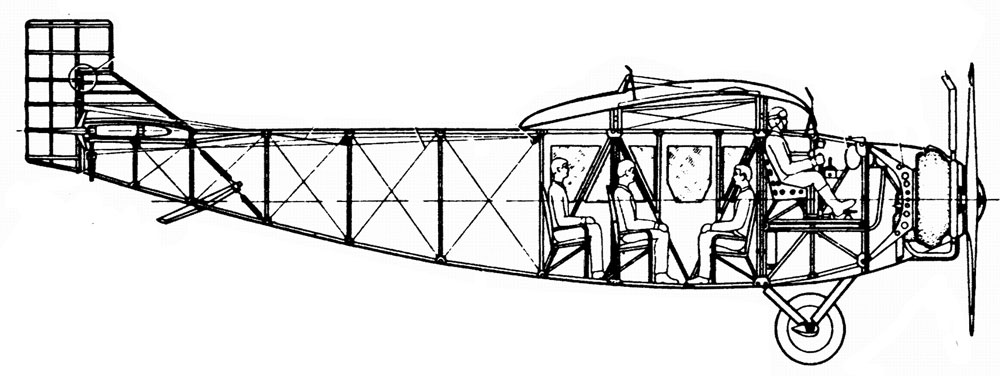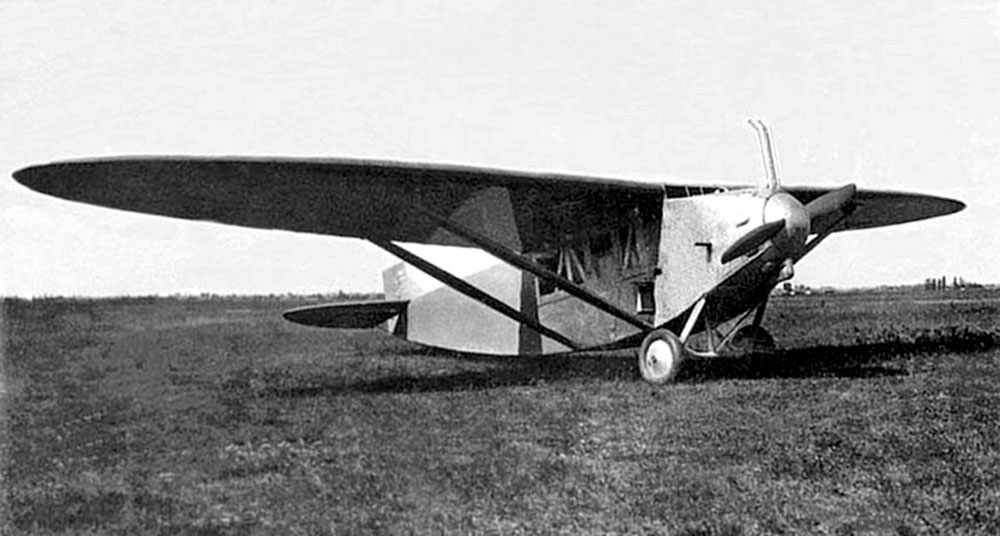This summer marked the 100th anniversary of the first flight of the Ukrainian passenger aircraft K-1, created under the leadership of Ukrainian Soviet aircraft designer, 1925 KPI graduate Konstantin Oleksiyovych Kalinin (1887-1938). This event took place on July 26, 1925.
✈️
It was the first aircraft in the former USSR to successfully pass state tests and be recommended for serial production and operation on civil aviation routes. However, despite the recommendations, its serial production was not established for various reasons.
At the same time, the K-1 aircraft became the basis for further projects by Konstantin Kalinin.
Back in May 1923, KPI student Konstantin Kalinin proposed to build a new passenger aircraft on his own at the Kiev aircraft repair plant “Rempovitryashlyakh-6.” At that time, Kalinin was not only studying at the Kyiv Polytechnic Institute, but also working as the production manager of this plant. The customer was the Ukrpovitryashlyakh company.
Other Kyiv Polytechnic students also participated in the design of the aircraft.
KPI students Mykola Zheleznykov and Dmytro Tomashevich (1899-1974), a future renowned aircraft designer and Doctor of Technical Sciences, calculated the strength of the wing, designed and constructed the steel tubular spars of the elliptical wing, and drew up diagrams. The consultant for aerodynamic calculations was KPI associate professor Mykola Petrov, the fuselage sketches were made by Stepan Dub, and the strength was calculated by student Mykola Zudin (1891-1968), a future scientist in the field of metal and wooden structures and construction mechanics, candidate of technical sciences, corresponding member of the Academy of Construction and Architecture of the Ukrainian SSR (1958). KPI mechanical engineering student S. Feynstein performed calculations for an important part of the tail assembly – the stabilizer. Student Volodymyr Savinsky performed calculations for the strength of the RVZ-6 K-1 aircraft and calculated the forces on the fuselage and all the corresponding diagrams. The aircraft drawings were made by students Andriy Rudenko and Oleksiy Hratsiankyi (1905-1987) – a future aircraft designer, Hero of the Soviet Union, 1st class test pilot, candidate of geographical sciences, who did a lot to rehabilitate K.O. Kalinin in the 1950s and restoring his name from oblivion.
 Layout diagram of the K-1 aircraft
Layout diagram of the K-1 aircraftIn specialized literature, the name of this aircraft is referred to either as K-1 (most often used after the surname of the chief aircraft designer, or as “collective”), or as RPZ-6-K-1 (official name – aircraft plant “Rempovitrya-6”) and K-1). However, in our opinion, it would be logical and fair to call the aircraft “RPZ-6-KPI” (joint work of the plant and the institute). This would most accurately reflect the essence of the joint work of the plant and the institute.
In December 1923, the project was completed. The future aircraft was intended for a variety of uses. For example, instead of a passenger cabin, it was possible to install medical equipment for transporting three patients or a pesticide sprayer for pest control in agriculture. If necessary, the aircraft could also be used as a bomber with a 480 kg bomb load or as a ground attack aircraft with armor for the crew and 16 machine guns.
Konstantin Kalinin managed to interest the management of Ukropovitryashlyakh in Kharkiv in the project and obtain funding for the construction of a prototype. The calculations were checked by Dmitry Ksandrov, a professor at the Kharkiv Technological Institute, who fully approved the project. On February 23, 1924, the K-1 project was approved by the Scientific and Technical Committee of the Air Force in Moscow.
In September 1924, construction of the prototype finally began in the workshops of the Rempovitrya-6 factory. It was not completed until June 1925, due to the quarrels of some and the sabotage of others among the factory's department heads. The main parts of the aircraft were assembled in a field near the factory, under the open sky.
 K. Kalinin and pilot S. Kosinsky after the first flight of the K-1 aircraft. Post-Volynskyi airfield (Kyiv, July 26, 1925)
K. Kalinin and pilot S. Kosinsky after the first flight of the K-1 aircraft. Post-Volynskyi airfield (Kyiv, July 26, 1925)The first flight of the K-1 passenger aircraft took place on July 26, 1925, at the Post-Volynsky airfield in Kyiv. It was piloted by a young pilot from the Kyiv garrison, Stanislav Kosinsky. Konstantin Kalinin himself flew with the pilot on the first flight. This would later become his main rule—to take the first flight and take risks together with the test pilot. Instead of the planned one lap over the field, the flight lasted 40 minutes and demonstrated the aircraft's good maneuverability and stability.
After fixing the defects and tweaking the steering wheel, in September 1925, the plane was flown to Kharkiv so that the folks at Ukrpovitryashlyakh could check it out. At the Sokolniki airfield, the new machine was successfully shown off to the Ukrainian government, and the pilot did a few demo flights over Kharkiv. On September 16, 1925, the aircraft flew the Kharkiv-Orel-Serpukhov-Moscow route, successfully covering a distance of 1,200 km in 8 hours and 35 minutes of flight time and landing at the Khodynsky airfield.
In October-November 1925, the aircraft successfully passed state tests. It was recommended for serial production and operation on civil aviation routes—for the first time in the USSR!
The photographs of the K-1 aircraft were taken in black and white. But in reality, it was not like that! A description of its paint scheme has been preserved. The metal fuselage skin was not painted. The fabric skin of the fuselage, wings, and tail had a light brown tint and was covered with transparent aerolacquer. The wing struts, stabilizer, and propeller were red or black (after repainting). The side number was black. The RPZ-6 K-1 mark was red with a white outline. The wheel caps were silver.
The aircraft was purchased by the Dobrolet company. It was given the registration number RR-DBE (later USSR-481) and was transferred to the Central Air Station in Moscow. It was used for passenger transport and aerial photography until 1930, spending more than 190 hours in the air.
At the end of December 1925, Konstantin Kalinin defended the K-1 project before the KPI diploma commission and received a degree in mechanical engineering.
Here are some technical characteristics of the K-1 aircraft. The wingspan was 16.76 m, the length of the aircraft was 10.72 m, the maximum take-off weight was 1,972 kg, the power of one Salmson PB-4 engine was 160 hp, and the maximum speed was 161.2 km/h. The practical flight range was 600 km, and the practical ceiling was 3 km. The crew consisted of two pilots, and the aircraft itself could carry three more passengers.
 The first passenger aircraft created in Ukraine, the K-1
The first passenger aircraft created in Ukraine, the K-1In January 1926, Kalinin was transferred from Kyiv to Kharkiv to the position of Chief Designer and Head of the Production Department of the Ukrpovitryashlyakh company. On September 17, 1926, the Kharkiv Aviation Plant was founded, and Konstantin Kalinin was its first director and chief designer until 1934. His subsequent aircraft, the so-called “standard type” K-2, K-3, and K-4, were based on the K-1 aircraft.
For a long time, information about the outstanding Ukrainian aircraft designer was hidden and carefully concealed. The author himself learned about him in his school years from an experimental textbook on the history of Ukraine published in 1992. He immediately remembered the name of the notorious “all-Union elder” – an associate of the bloody “leader of the peoples.” The author is very grateful to fate for bringing him together with Konstantin Kalinin's daughter, Nelly Konstantinovna (1926-2012). She lived in Moscow, but decided to transfer her father's documents and some of his belongings to Ukraine, since Kalinin created his aircraft in Kyiv and Kharkiv. However, there was another reason: even then, in 2005, Nelly Konstantinovna saw that a totalitarian regime was emerging in the Russian Federation, which had killed her father and consigned his name to oblivion for many years. She said to me: “Putin will not leave you, the people of Ukraine, alone. He is a terrible person and will definitely attack.” What a prophetess she turned out to be! At the time, the author just smiled and shrugged his shoulders...
At the same time, Nelly Kostiantynivna expressed great hope that the monument to her father would be in Ukraine. And time justified her hopes.
Back in April 2007, the State Polytechnic Museum organized an exhibition entitled “His chord has not yet faded...” to mark the 120th anniversary of the aircraft designer's birth. And on May 14, 2008, the renovated Department of Aviation and Cosmonautics History named after I.I. Sikorsky of the State Polytechnic Museum was opened in the former building of the KPI aviation and automobile workshops. A prominent place in the exhibition was given to the section on K.O. Kalinin, formed using materials provided by his daughter, as well as those found in the archives and libraries of Kyiv and Ukraine.
The staff of the State Polytechnic Museum constantly brought up the idea of erecting a monument or memorial plaque to K.O. Kalinin, at least on the KPI campus, to the university administration. At the same time, the museum has repeatedly appealed to the Solomyanskyi District Administration in Kyiv to rename one of the streets in the district in honor of aircraft designer Konstantin Kalinin. However, a striking example of the ignorance of officials was the constant confusion or even association of the aircraft designer with the Soviet party and state leader, “All-Union Starosta” Mikhail Kalinin.
On the initiative of Bogdan Andriytsiv, a member of the board of trustees of the National Technical University of Ukraine “KPI,” managing partner of Island Management, and Volodymyr Hnat, head of the Kalinin Invention Fund, the necessary amount was found. A competition was held, and the winners were young sculptors Nikita and Yegor Zigury. On August 28, 2014, the grand opening of the monument took place at the university.
In March 2014, the project gained momentum. Thanks to the initiative of Bogdan Andriytsiv, a member of the NTUU “KPI” Board of Trustees, managing partner of Island Management, and Volodymyr Hnat, head of the Kalinin Invention Fund, the necessary funds were raised. A competition was held, and the winners were young sculptors Nikita and Yegor Zigury. On August 28, 2014, the university held a grand opening of the Walk of Fame and a monument to the outstanding domestic aircraft designer Konstantin Kalinin.
 Monument to aircraft designer K.O. Kalinin in KPI. (Opened on August 28, 2014)
Monument to aircraft designer K.O. Kalinin in KPI. (Opened on August 28, 2014)The opening ceremony was attended by the rector of NTUU “KPI”, academician of the National Academy of Sciences of Ukraine Mykhailo Zgurovsky, director of the representative office of the Kharkiv State Aviation Production Enterprise V. Guba, deputy director of the Antonov Serial Plant (Kyiv Aviation Plant “Aviant”) V. Astashkin, chief technologist of the Antonov Serial Plant G. Romanovich, heads of sponsoring companies, students, employees, and guests of the university.
...Several decades ago, Ivan Artobolevsky (1905-1977), an outstanding domestic scientist in the field of machine and mechanism theory and academician of the USSR Academy of Sciences, noted: "There were two great aircraft designers – Igor Sikorsky and Konstantin Kalinin. The first was buried by America as a national hero, while the second is unknown to us..." Today, this mistake has been partially corrected.

